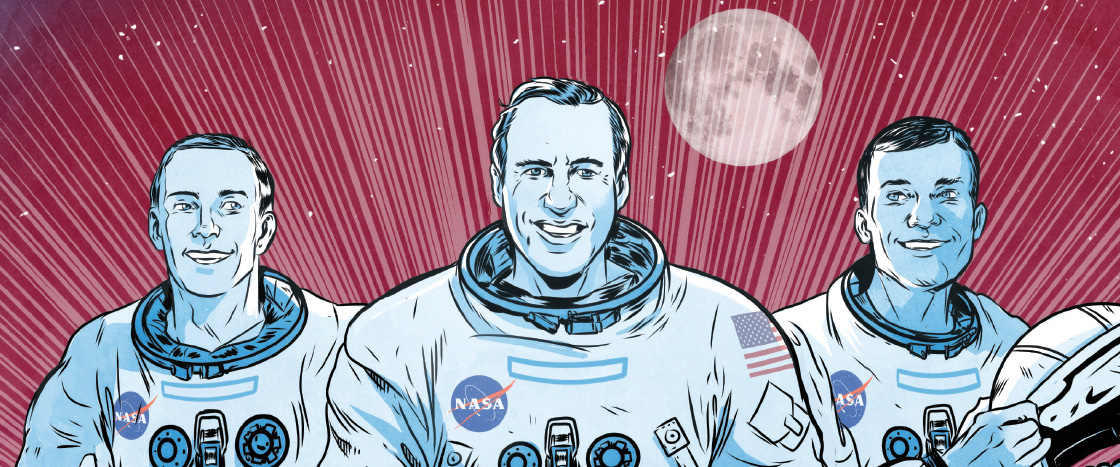"I’m Jack Swigert. I’ll pilot the ship in space."
"I’m Jim Lovell. I’m leading the mission."
"And I’m Fred Haise. I’ll pilot the Lunar Module, which will take us to the moon’s surface. Let’s go!"

Three astronauts headed for the moon on the Apollo 13 mission. Then disaster struck. Would they make it home alive?
Learning Objective: Students will explain how astronauts and mission control used communication and engineering skills to solve problems in space.
"I’m Jack Swigert. I’ll pilot the ship in space."
"I’m Jim Lovell. I’m leading the mission."
"And I’m Fred Haise. I’ll pilot the Lunar Module, which will take us to the moon’s surface. Let’s go!"
April 11, 1970: The Apollo 13 spacecraft was launched, headed for the moon! Once in space, the outer rocket fell away. The spacecraft had three main modules, or sections.
Service Module: Contained supplies, including tanks of cold liquid oxygen. At room temperature, the oxygen turned to breathable gas.
Command Module (Odyssey): Where the astronauts piloted the ship, ate, and slept
Luna Module (Aquarius): Designed to carry two people to the surface of the moon.
What is the purpose of each module? Why do you think the modules have different designs?
NASA’s mission control in Houston, Texas, tracked the spacecraft and spoke to the astronauts via radio.
"Good job, everyone! Stay on course."
April 13: The astronauts gave a televised tour of their tiny home.
"This is where I fly the ship!"
"And this is what we’ll take to the moon."
After the TV tour, it was time to mix the liquid oxygen stored in the Service Module. Fans had to stir the oxygen regularly so it didn’t settle at the bottom of the tanks.
"Time to stir up your oxygen tanks."
"Turn on the fans in the tanks? You bet."
An explosion rocked the ship! The insulation on a wire in an oxygen tank had worn away. The oxygen caused the wire to catch fire.
"Houston, we have a problem here!"
"We’re losing power and oxygen fast!"
The astronauts hurried to the Aquarius! They’d have to rely on its power and oxygen.
"But the Aquarius was built to hold just two people!"
"And only for two days!"
"We’ll have to squeeze in!"
Back on Earth, mission control made a plan to get the crew home. The spacecraft would head to the moon and use its gravity to slingshot around it and back to Earth.
"They’ll need to drink less water and use less power to make it back alive."
"We need to make it work."
With the power turned down, the Aquarius grew cold. The men drank as little water as possible.
"Want any water, Jack?"
"No, save it for later."
How do you think the astronauts and members of mission control felt? Explain.
April 15: Now the astronauts faced a new problem. Each time they exhaled, they breathed out carbon dioxide (CO₂) gas. It was building up to deadly levels! The astronauts needed a way to filter it out quickly, using only objects on the spacecraft.
"The Odyssey has CO2 filter cells. What if we used them?"
"But they’re square! Only round filters can fit in the Aquarius . . ."
In nine hours, mission control engineers designed an adapter to fit the square filters into the Aquarius. Then they explained to the crew how to build it.
"We can’t send a picture, so listen closely."
"Roger that."
"We’ve gathered the materials."
"I’ve got . . . duct tape, plastic bags, note cards . . ."
The crew followed the directions. In just a few hours, they were finished.
"I hope this works."
"CO2 levels are falling! Phew!"
April 17: As the astronauts neared Earth, they returned to the Odyssey. The Aquarius and the Service Module weren’t built to reenter Earth’s atmosphere. They had to be released.
"WHOA! Look at the damage!"
The Odyssey and its crew plunged to Earth. Against all odds, they had survived!
"They made it!"
"Home sweet home!"
1. PREPARE TO READ (10 minutes)
Activate prior knowledge with a class discussion and an interactive video.
2. READ AND ANALYZE (20 minutes)
Read the mini graphic novel and evaluate the problem-solving skills shown.
2. RESPOND TO READING (30-45 minutes)
Build an adapter, communicate the design, and reflect on the process.